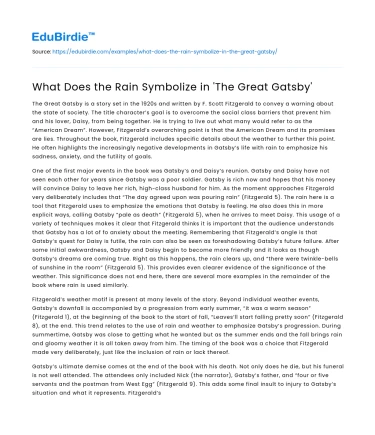The Great Gatsby is a story set in the 1920s and written by F. Scott Fitzgerald to convey a warning about the state of society. The title character’s goal is to overcome the social class barriers that prevent him and his lover, Daisy, from being together. He is trying to live out what many would refer to as the “American Dream”. However, Fitzgerald’s overarching point is that the American Dream and its promises are lies. Throughout the book, Fitzgerald includes specific details about the weather to further this point. He often highlights the increasingly negative developments in Gatsby’s life with rain to emphasize his sadness, anxiety, and the futility of goals.
One of the first major events in the book was Gatsby’s and Daisy’s reunion. Gatsby and Daisy have not seen each other for years since Gatsby was a poor soldier. Gatsby is rich now and hopes that his money will convince Daisy to leave her rich, high-class husband for him. As the moment approaches Fitzgerald very deliberately includes that “The day agreed upon was pouring rain” (Fitzgerald 5). The rain here is a tool that Fitzgerald uses to emphasize the emotions that Gatsby is feeling. He also does this in more explicit ways, calling Gatsby “pale as death” (Fitzgerald 5), when he arrives to meet Daisy. This usage of a variety of techniques makes it clear that Fitzgerald thinks it is important that the audience understands that Gatsby has a lot of fo anxiety about the meeting. Remembering that Fitzgerald’s angle is that Gatsby’s quest for Daisy is futile, the rain can also be seen as foreshadowing Gatsby’s future failure. After some initial awkwardness, Gatsby and Daisy begin to become more friendly and it looks as though Gatsby’s dreams are coming true. Right as this happens, the rain clears up, and “there were twinkle-bells of sunshine in the room” (Fitzgerald 5). This provides even clearer evidence of the significance of the weather. This significance does not end here, there are several more examples in the remainder of the book where rain is used similarly.
Save your time!
We can take care of your essay
- Proper editing and formatting
- Free revision, title page, and bibliography
- Flexible prices and money-back guarantee
Fitzgerald’s weather motif is present at many levels of the story. Beyond individual weather events, Gatsby’s downfall is accompanied by a progression from early summer, “it was a warm season” (Fitzgerald 1), at the beginning of the book to the start of fall, “Leaves’ll start falling pretty soon” (Fitzgerald 8), at the end. This trend relates to the use of rain and weather to emphasize Gatsby’s progression. During summertime, Gatsby was close to getting what he wanted but as the summer ends and the fall brings rain and gloomy weather it is all taken away from him. The timing of the book was a choice that Fitzgerald made very deliberately, just like the inclusion of rain or lack thereof.
Gatsby’s ultimate demise comes at the end of the book with his death. Not only does he die, but his funeral is not well attended. The attendees only included Nick (the narrator), Gatsby’s father, and “four or five servants and the postman from West Egg” (Fitzgerald 9). This adds some final insult to injury to Gatsby’s situation and what it represents. Fitzgerald’s message about the futility of the American dream can be seen here. Fitzgerald mentions the start of a rainstorm before Gatsby’s funeral begins when Nick says “I got back to West Egg in a drizzle” (Fitzgerald 9) as he leaves work. It becomes a “thick drizzle” (Fitzgerald 9) by the time the funeral procession gets to the cemetery. In the end, few people cared enough about Gatsby to go to his funeral. Fitzgerald’s message is clear, on the level of the story, Gatsby’s goals were impossible and doomed to failure from the beginning. More abstractly, the American Dream is futile and impossible. Gatsby’s attempt to live out the dream results in him being killed and then quickly forgotten. The rain reflects the emotions evoked by the situation and those felt by the few who cared about Gatsby. This is the warning that Fitzgerald wants to convey to his audience.
The motif of weather is a tool Fitzgerald uses to support the point he is trying to make. He repeatedly uses rain and other details about the weather and seasons to effectively demonstrate the futility of the American Dream. The rain at the beginning of the story foreshadows Gatsby’s demise and highlights Gatsby’s emotions. The last rain and the overall transition from summer to fall throughout the book track with his progressive downfall and finally his death and failure. Gatsby’s death is the main device that Fitzgerald uses to communicate his more general point about the American Dream and society. He is urging his audience to reconsider popular contemporary ideas about success, wealth, and class.






 Stuck on your essay?
Stuck on your essay?

